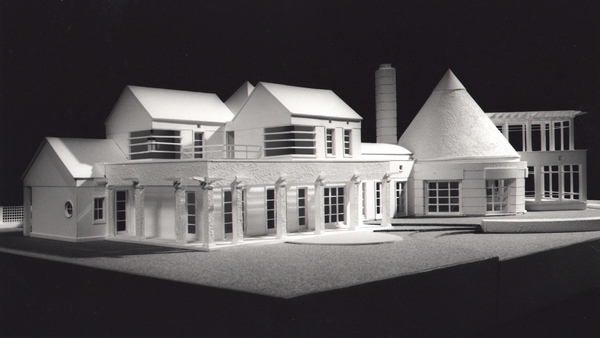
As far as architects are concerned, Gary Lawrance is old school. He constructs models by hand, rather than with a computer; with paper instead of plastic and wood.
“I do work in paper because they are meant to be changed,” Mr. Lawrance said. “These models are working models. They’re meant to be taken apart, I like to think I put them together again.”
Some of Mr. Lawrance’s model work is on exhibit at the Southampton Historical Museum. The exhibit largely introduces his work to the layman, though he is already well known among his fellow architects for his intricate models.
“What Gary creates are almost art pieces,” said Peter Cook, an architect based in Bridgehampton who has worked with Mr. Lawrance for 20 years. A few of Mr. Cook’s projects with Mr. Lawrance are included in the exhibit. “His product is probably the most valuable preliminary design tool an architect could use.”
Mr. Lawrance, a frequent Hamptons visitor and the principal in Stony Brook-based Lawrance Architecture, said he’s at his busiest when he has model requests from three or four different architects at the same time. A typical model usually takes about a month.
For the architects who work with Mr. Lawrance, the models are worth the wait.
“The work that he did was phenomenal and I was awed by the detail and experience,” said Anthony J. Musso, an architect who has worked with Mr. Lawrance on many of his residential homes on the North Shore of Long Island. “He’s got a good sense of the historical aspect of things, and a very talented guy.”
History is important to Mr. Lawrance. It’s actually what got him interested in architecture in the first place, he said during a recent walk-through of his exhibit at the Southampton Historical Museum.
“When I was a child my parents always planned their summer vacations, but we always had to see this mansion, we always had to go to Newport [Rhode Island] repeatedly or up the Hudson River to see Lyndhurst Castle and Old Westbury Gardens,” Mr. Lawrance said. “I was always fascinated by, let’s say, gilded-age architecture.”
In the present day, Mr. Lawrance’s works are, in a sense, gilded. Unlike many model-making firms who use wood and plastic to build models, Mr. Lawrance prefers using paper, he said. Paper makes it easier to keep planning flexible for his clients—the architects who ask him for models—and their clients, the prospective homeowner, Mr. Lawrance explained.
“The model might be presented to the client, and then you know the client might want to say, let’s put more doors here, or change the garages,” he said.
Mr. Lawrance said he is constantly asked whether computer modeling is going to put an end to his line of work. But at least one of his clients said prefers Mr. Lawrance’s approach to model-making over the more technologically advanced method.
“They have all of these computer programs, I don’t think anything replaces the three-dimensional access of a model, and his work again is integral to our process,” said Brian Shore, an architect from Locust Valley who has worked frequently with Mr. Lawrance. “To me he doesn’t provide for us a product, he provides for us a service.”
Mr. Lawrance said his biggest concern with computers is the effect they’ve had on modeling materials, such as the small pieces of tape he uses to represent window frames.
“All of these materials are being discontinued, so sometimes some of the things I use and find, I buy a lot of because you’re not getting the papers you once had,” he said, adding that the Southampton Historical Museum would have be unable to showcase his models had they been done exclusively on computers.
Southampton Historical Museum Executive Director Tom Edmonds said that he, for one, is glad that Mr. Lawrance still works with tools instead of a keyboard.
“Coming in and looking at a mini-house like this is just fun,” Mr. Edmonds said. “It wasn’t something that started out being well-known or appreciated in the public, but I think word of mouth has spread Gary’s show so more people are looking at it.”
When Mr. Lawrance isn’t working, which isn’t very often as he’s had years where he constructed upward of 40 different models, he has his own special pet project.
“In downtime I do sort of design my dream house,” Mr. Lawrance said. “To me a house would be mostly books. Books and artwork and sculpture.”
However, there’s one problem with Mr. Lawrance’s dream house, he said. He really needs to stretch his imagination even more than he does for his usual projects.
“It would require a site that doesn’t exist in reality. It would require a high sort of hill with a cliff, with the ocean crashing around it. So you would have to find the site for such a house.”
The Southampton Historical Museum will exhibit Mr. Lawrance’s “Phenomenal Places” through Saturday, September 3. The exhibit is open from 11 a.m. to 4 p.m. Tuesdays Through Saturdays. There is a $4 fee for adults. There is no cost of admission for museum members or children under the age of 17. For more information, call 283-2494 or visit southamptonhistoricalmuseum.org.